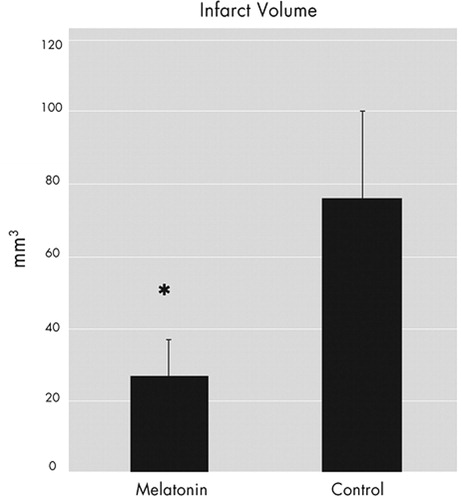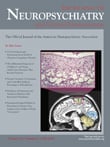Melatonin: A Suitable Agent for Depression Associated with Stroke?
To the Editor: It is widely known that occurrence of poststroke mood disorders, especially depression, is one of the most frequent complications of stroke. 1 It affects approximately 20%–40% of all patients and the definitive treatment of this clinical picture includes various antidepressant agents. 1
The evidence about the antidepressant-like activity of melatonin and melatonin agonists is rapidly increasing. 2 – 7 However melatonin is also an important agent in sleep disturbances, which are shown to be associated with stroke. 8 In light of these findings we wanted to evaluate whether this novel antidepressant agent also has neuroprotective effect on cerebral ischemia.
To examine this matter we evaluated the neuroprotective effect of melatonin in a relevant model for stroke in humans. Thus we administered the indole prophylactically for 4 weeks before the middle cerebral artery thread occlusions and evaluated the effects of melatonin treatment on ischemic brain injury 24 hours after reperfusion. Reproducibility of cerebral ischemia was controlled by Laser Doppler Flowmetry, and the neuroprotection was evaluated by infarct volume measurements ( Figure 1 ). Melatonin significantly reduced the infarct size ( Figure 1 ) (mean 1.12±0.5 mm 3 compared to 2.62±0.5 mm 3 ) when given prophylactically (p<0.05). This study was interesting with regard to poststroke depression by which a mood stabilizer with neuroprotective property would be preferable. Additionally, this finding supports that melatonin may be a suitable agent for patients with stroke and sleep disturbances, not only with its inhibiting effect on ischemic neuronal injury, but also with its improving effect on sleep disturbances. This can in turn provide additional support for the restorative process after brain injury.

Melatonin led to a decrease in infarct size in treated animals. *Significantly different from vehicle-treated control animals (p≤0.05).
However, further experiments to evaluate the long-term clinical applicability of such neuroprotective effects of melatonin in poststroke depression patients with MRI and spectroscopy studies would be the logical future steps to be taken in the field of psychiatric research.
1 . Whyte EM, Mulsant BH: Poststroke depression: epidemiology, pathophysiology and biological treatment. Biol Psychiatry 2002; 52:253–264Google Scholar
2 . Bertaina-Anglade V, la Rochelle CD, Boyer PA, et al: Antidepressant-like effects of agomelatine (S 20098) in the learned helplessness model. Behav Pharmacol 2006; 17:703–713Google Scholar
3 . Ergün Y, Ergün UG, Orhan FO, et al: Co-administration of a nitric oxide synthase inhibitor and melatonin exerts an additive antidepressant-like effect in the mouse forced swim test. Med Sci Monit 2006; 12:BR307–312Google Scholar
4 . Sumaya IC, Masana MI, Dubocovich ML: The antidepressant-like effect of the melatonin receptor ligand luzindole in mice during forced swimming requires expression of MT2 but not MT1 melatonin receptors. J Pineal Res 2005; 39:170–177Google Scholar
5 . Barden N, Shink E, Labbé M, et al: Antidepressant action of agomelatine (S 20098) in a transgenic mouse model. Prog Neuropsychopharmacol Biol Psychiatry 2005; 29:908–916Google Scholar
6 . Loiseau F, Le Bihan C, Hamon M, et al: Antidepressant-like effects of agomelatine, melatonin, and the NK1 receptor antagonist GR205171 in impulsive-related behaviour in rats. Psychopharmacology (Berl) 2005; 182:24–32Google Scholar
7 . Mantovani M, Pértile R, Calixto JB, et al: Melatonin exerts an antidepressant-like effect in the tail suspension test in mice: evidence for involvement of N -methyl- D -aspartate receptors and the L-arginine-nitric oxide pathway. Neurosci Lett 2003; 343:1–4 Google Scholar
8 . Kunz D, Mahlberg R, Muller C, et al: Melatonin in patients with reduced REM sleep duration: two randomized controlled trials. J Clin Endocrinol Metab 2004; 89:128–134Google Scholar



